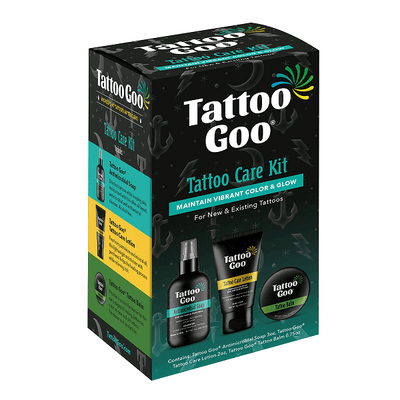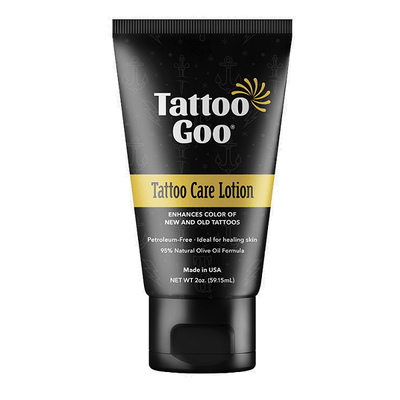Picture this: your client walks out of your tattoo studio, their new ink shining proudly on their skin, a smile of satisfaction on their face. But as the initial excitement wears off, reality sets in – the discomfort and potential challenges of the post-tattoo period. The itching, the peeling, the worry about preserving the vibrant artwork.
As a tattoo artist, your commitment doesn't end with the final needle stroke. Ensuring your clients' protection and comfort after a tattoo is a crucial step in not only delivering a great experience but also maintaining the integrity of your artistry. In this article, we will guide you through essential steps to help your clients experience protection and comfort after getting a tattoo.
1. Provide clear aftercare instructions
Clear, thorough and proper tattoo aftercare instructions are the foundation of a successful tattoo healing process. Provide your clients with a printed or digital copy of these instructions, and take the time to explain each step to them before they leave your studio. Include details on cleaning the tattoo gently, applying a thin layer of ointment, avoiding long sun exposure, and proper dressing techniques. Empower your clients with knowledge so they can actively participate in their own aftercare.
For an in-depth guide on providing your clients with protection and comfort after getting a tattoo, including proper aftercare instructions, check out our article on New tattoo aftercare: How to keep your ink looking great. This comprehensive resource helped a lot of tattoo artists in ensuring their clients' tattoos heal beautifully and maintain vibrancy.
2. Recommend quality tattoo aftercare products
Recommend specific tattoo aftercare products from a tattoo brand that you trust. These products should be hypoallergenic, and designed to support the healing process. Provide your clients with the option to purchase these products directly from your studio or recommend reputable retailers.
For a comprehensive aftercare solution, consider the Tattoo Goo Tattoo Care Kit. This kit includes soap, lotion, and balm – everything your clients need to ensure proper healing and comfort for their new tattoo. Check it out now and offer your clients a premium aftercare solution for their fresh ink.
3. Emphasise hygiene and sanitation
During the tattooing process, you've likely adhered to stringent hygiene standards. Extend this attention to cleanliness when discussing new tattoo care. Emphasise the importance of washing hands before touching the tattoo and using clean, non-abrasive materials to pat the tattoo dry after cleaning. Advise against applying lotions or creams with unwashed hands to prevent the introduction of germs.
4. Address concerns promptly
Make sure your clients know that it's normal for tattoos to go through various stages of healing, including scabbing, peeling, and itching. Address their concerns calmly and provide reassurance based on your expertise. However, if they experience signs of infection, such as excessive redness, swelling, or discharge, recommend seeking medical attention promptly.
5. Follow-up and offer touch-up services
Consider offering a follow-up appointment for your clients a few weeks after the tattooing process. This gives you the opportunity to assess the healing progress, provide any necessary touch-ups, and answer any additional questions they might have.
Moreover, offering touch-up services for your clients not only enhances their satisfaction but also showcases your commitment to delivering the best possible result. Explain how touch-ups work and how they can help the tattoo age gracefully.
6. Choosing the right clothing
Suggest loose-fitting, breathable clothing that won't rub against the fresh tattoo. Tight clothing can irritate the area and disrupt the healing process. If the tattoo is in an area that's difficult to cover with clothing, recommend using a clean and soft cloth to act as a barrier between the tattooed skin and the fabric.
For larger tattoos or those in areas prone to friction, such as the lower back or underarms, recommend using a non-stick dressing. This type of dressing won't adhere to the tattoo, reducing the risk of scabbing being pulled off prematurely.

7. Educate about potential risks
It's crucial to have a candid conversation about the possible risks associated with getting a tattoo. This should include possible allergic reactions to the ink, signs of infection, and the importance of medical consultation if symptoms of complications arise. Understanding these risks empowers clients to make informed choices about aftercare and encourages them to act swiftly should any problem surface.
This conversation isn't intended to scare your clients but to prepare them for every possible scenario. By doing so, you're fostering a relationship built on transparency and trust, which can be invaluable for your professional reputation.
8. Discuss the importance of sun protection
Direct sunlight and UV radiation can lead to fading and complications during the healing process. Encourage your clients to keep the tattoo covered, especially during the initial healing weeks, to avoid prolonged sun exposure. If they must be outdoors, advise them to use a high-SPF sunscreen on the tattooed area and cover it with clothing if possible.
9. Moisturising the tattoo
Hydrated skin heals better and reduces itching, which is a common complaint during the healing process. Recommend a gentle, fragrance-free moisturiser that is free from harsh chemicals. Regular moisturising not only helps with healing but also contributes to maintaining the tattoo's vibrancy.
For those specifically looking for a product designed for tattoo care, consider trying the Tattoo Goo Aftercare Lotion. It's formulated to provide the nourishment tattoos need. Check it out!
10. Avoid swimming and soaking
Advise against swimming in pools, hot tubs, or natural bodies of water during the initial healing phase. Soaking the tattoo can lead to infections and colour loss. Suggest taking showers instead of baths. When it's time to wash the tattoo, it's essential to gently wash the area, avoiding direct water pressure on the tattoo during showers.
11. Healthy lifestyle choices
Educate your clients about how their overall health can impact how the tattoo heals. A balanced diet rich contributes to optimal healing. Additionally, encourage them to avoid excessive alcohol consumption and smoking, as these habits can slow down healing and affect the tattoo's final appearance.
Takeaway
Your commitment to your client's well-being extends beyond the confines of your studio. By ensuring their protection and comfort after the tattooing process, you not only offer an exceptional experience but also establish a reputation built on genuine care and professionalism.
Remember, a successful tattoo journey doesn't conclude with the final design – it encompasses the entire healing phase, creating lasting impressions of a meticulous and caring artist.





























































 Studio supplies
Studio supplies












 Power & batteries
Power & batteries







 Aftercare
Aftercare



















 Apprentice
Apprentice


 Piercing & jewellery
Piercing & jewellery







 PMU supplies
PMU supplies



 New arrivals
New arrivals
 Gift vouchers
Gift vouchers
 Shop all
Shop all












































